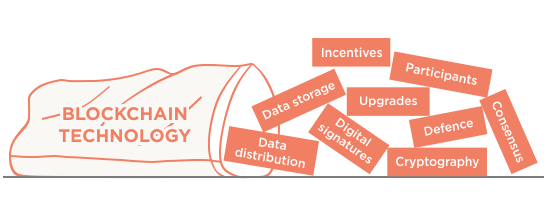This article is a gentle introduction to blockchain technology and assumes minimal technical knowledge. It attempts to describe what it is rather than why should I care, which is something for a future post.

People use the term ‘blockchain technology’ to mean different things, and it can be confusing. Sometimes they are talking about The Bitcoin Blockchain, sometimes it’s The Ethereum Blockchain, sometimes it’s other virtual currencies or digital tokens, sometimes it’s smart contracts. Most of the time though, they are talking about distributed ledgers, i.e. a list of transactions that is replicated across a number of computers, rather than being stored on a central server.
The common themes seem to be a data store which:
- usually contains financial transactions is replicated across a number of systems in almost real-time
- usually exists over a peer-to-peer network
- uses cryptography and digital signatures to prove identity, authenticity and enforce read/write access rights
- can be written by certain participants
- can be read by certain participants, maybe a wider audience, and
- has mechanisms to make it hard to change historical records, or at least make it easy to detect when someone is trying to do so
I see “blockchain technology” as a collection of technologies, a bit like a bag of Lego. From the bag, you can take out different bricks and put them together in different ways to create different results.

What’s the difference between a blockchain a a normal database? Very loosely, a blockchain system is a package which contains a normal database plus some software that adds new rows, validates that new rows conform to pre-agreed rules, and listens and broadcasts new rows to its peers across a network, ensuring that all peers have the same data in their databases
Hi! I am a robot. I just upvoted you! I found similar content that readers might be interested in:
https://bravenewcoin.com/assets/Reference-Papers/A-Gentle-Introduction/A-Gentle-Introduction-To-Blockchain-Technology-WEB.pdf